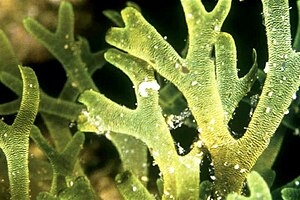Common fork tongue
| Common fork tongue | ||||||||||||
|---|---|---|---|---|---|---|---|---|---|---|---|---|

Common fork tongue ( Dictyota dichotoma ) |
||||||||||||
| Systematics | ||||||||||||
|
||||||||||||
| Scientific name | ||||||||||||
| Dictyota dichotoma | ||||||||||||
| ( Huds. ) JV Lamour. |
The common fork tongue ( Dictyota dichotoma ) is a brown alga from the group of Dictyotales . It is distributed almost worldwide on the sea coasts and is also found in the North Sea.
description
The common fork tongue has a bushy, yellow-brown to olive-brown thallus that is 10 to 15 (rarely up to 35) centimeters high. It consists of quite regularly forked flat bands 2 to 15 (rarely up to 30) millimeters wide. They are very variable in appearance, so they can be spirally twisted or flat, and end blunt-rounded or slightly tapered.
The dichotomous branching occurs when the apex cell divides lengthways at the end of the thallus. The thallus consists of an inner tissue of large cells between two outer layers of cortex made of small cells.
Development cycle
The generational change of the common fork tongue shows two identical (isomorphic) generations. The sporophytes are narrower than the gametophytes . The reproductive organs are distributed over the entire surface of the thallus (with the exception of the edge), which makes it appear finely dotted. The sporophyte releases immobile spores . These grow into male and female gametophytes, on which the egg cells or spermatozoids arise.
Occurrence
The common fork tongue is widespread on the sea coasts worldwide. In the Atlantic , it occurs from Scandinavia to the Canary Islands and West Africa , and from the Caribbean to Brazil . It also thrives in the Mediterranean . Their area also includes coasts in the Pacific (Japan, China, Chile), in the Indian Ocean , off Australia and New Zealand as well as in the sub-Antarctic .
In the North Sea the way in was Helgoland and in the North Frisian Wadden Sea proved. While it was still abundant at Helgoland in the 1930s, it became increasingly rare until the 1980s. After disappearing for a few decades, it reappeared in 1999. The reasons for these strong fluctuations in stocks are not known.
The fork tongue grows on firm ground from the middle to lower tidal zone to the sublittoral . It was found even at a depth of more than 50 meters.
Systematics
The species was first described in 1762 by William Hudson under the name Ulva dichotoma (in: Flora anglica , p. 476). Jean Vincent Félix Lamouroux placed the species in 1809 in the genus Dictyota . Dictyota dichotoma is the type species of this genus.
The species was temporarily assigned to other genera and referred to as Dichophyllium dichotomum (Hudson) Kützing, Fucus dichotomus (Hudson) Bertolini, Haliseris dichotoma (Hudson) Sprengel, Ulva dichotoma Hudson and Zonaria dichotoma (Hudson) C. Agardh . In addition, there are numerous other synonyms : Dictyota acute Kiitzing, Dictyota acuta var. Patens Kiitzing, Dictyota aequalis var. Minor Kiitzing, Dictyota apiculata J.Agardh. Dictyota areolata Schousboe, Dictyota attenuata Kiitzing, Dictyota complanata Schousboe ex Bornet, Dictyota elongata Kiitzing, Dictyota latifolia Kützing, Dictyota rotundata JV Lamouroux, Dictyota setosa Duby, Dictyota volubilis Kützing, Neurocarpus annularis Schousboe, Neurocarpus areolatus Schousboe, Zonaria rotundata (Lamouroux) C. Agardh and Fucus zosteroides JVLamourouxides.
use
Divers can use the common fork tongue to rub their diving masks , which is to prevent the glasses from fogging up.
swell
- ↑ Michael Guiry: The Seaweed Site: information on marine algae: Dictyota dichotoma , accessed November 10, 2014.
- ↑ a b c d e Wolfram Braune: Marine algae. A color guide to the common benthic green, brown and red algae of the world's oceans . Ruggell: Gantner, 2008, ISBN 978-3-906166-69-8 , pp. 126-127.
- ↑ a b c d P. Kornmann, PH Sahling: Sea algae from Helgoland - Benthic green, brown and red algae. Biological Institute Helgoland, Hamburg 1983, ISSN 0017-9957 , p. 161.
- ↑ Dirk Schories, Uwe Selig, Hendrik Schubert: Species and synonym list of the German marine macroalgae based on historical and recent records (list of species and synomes of macroalgae in German coastal waters - evaluation of historical and recent findings) . In: Rostock. Marine biologist Contribution , Issue 21, 2009, p. 39. PDF file
- ^ Inka Bartsch, Ralph Kuhlenkamp: Development of macrophyte vegetation near Helgoland against the background of the Water Framework Directive . In: Meeresumwelt Aktuell North Sea and Baltic Sea , 2009/1, p. 3. PDF file
- ↑ a b Michael D. Guiry in Michael D. Guiry, GM Guiry: Dictyota dichotoma - In: AlgaeBASE - World-wide electronic publication, National University of Ireland, Galway, accessed November 10, 2014.

